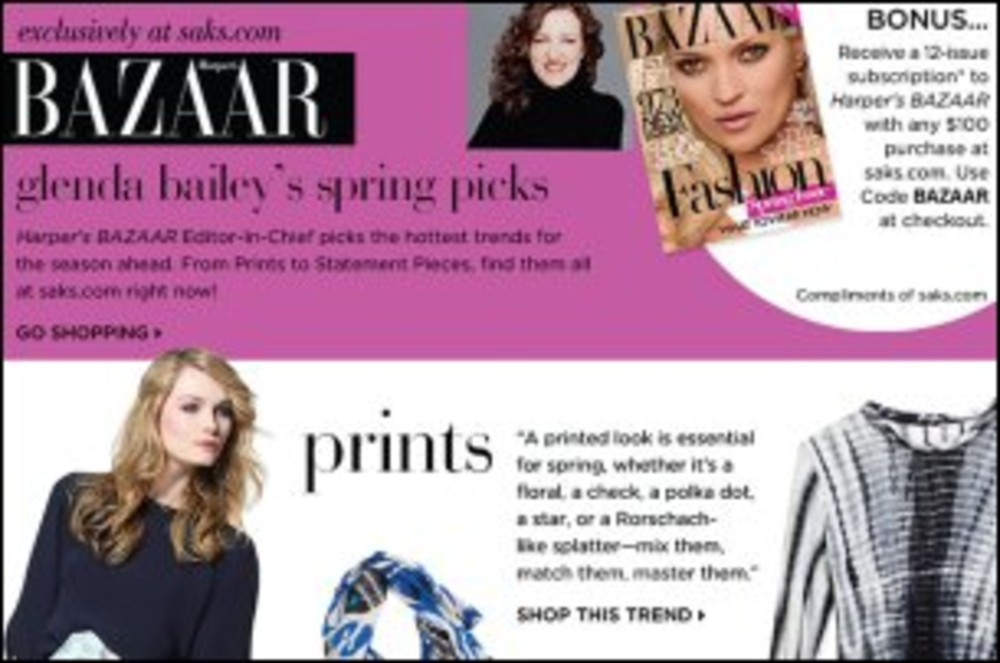In an e-mail, Harper’s Bazaar editor Glenda Bailey describes the spring’s hot fashion trends — prints, soft tailoring and bold and pastel colors.
The e-mail, however, was not sent by the style and beauty magazine, but instead by Saks Fifth Avenue.
Whether in e-mail, on websites or in catalogs, fashion retailers are giving marketing more of an editorial touch.
Saks also teamed up with Details editor Daniel Peres, who has offered his men’s fashion picks, and the luxury retailer’s website has included videos featuring advice from designers such as Stacey Bendet, Tory Burch and Michael Kors.
“Our customers are fashionistas and are certainly interested and aware of what’s going on in fashion,” says Kimberly Grabel, SVP of marketing at Saks Fifth Avenue.
Saks is not alone in capitalizing on this trend. Banana Republic’s website, for example, includes a feature called “BR StyleScene,” which resembles a five-page magazine with several interviews and embedded video links.
On Fossil’s website, the clothing and accessories chain publishes a blog, staff picks and city guides.
Magalog vs. Catalog
Creative Direct Marketing Group is one company that helps organizations develop magalogs for their brands. Craig Huey, president of the agency, explains that a number of industries, not just the fashion world, make use of this growing marketing tactic.
“In the consumer market, we’ve used it for a lot of investment products, nutritional products, different publications, reverse mortgages, children’s toys,” he says.
Huey says that the designed look of magalogs help these pieces get by a picky mailroom where many catalogs are tossed out as “junk,” never making it to the hands of the intended recipient. “A magalog looks like a magazine,” he says. “It looks valuable.”
One of the striking differences between magalogs and catalogs is that the magalog carries less product but includes more information, creative page design and often larger, more stylized photos. “The editorial helps increase the response rate,” Huey adds.
He says it’s hard to generalize on an overall response rate for magalogs, but offers a comparison. “If I normally would only get a 1% response rate, with a magalog I can get a 1.6%, 1.8%, up to 2%,” Huey says.
Fossil’s catalog, meanwhile, could be mistaken for a fashion magazine. The latest publication includes several full-page photos of models bicycling or frolicking through the rain.
“We’ve never really considered any other way to do our catalog,” says Jill Elliott-Sones, creative director at Fossil. “Our brand and our products are so rich in our authentic modern vintage story, and we strive to share that through our photography, lifestyle images and the locations we shoot in.”
Magalogs, or catalog and magazine hybrids, are growing in popularity.
Lands’ End and J. Crew both publish magalogs. After a seven-year hiatus, Abercrombie & Fitch revived its racy A&F Quarterly in July, which the apparel chain sells for $10 an issue.
Zappos, which made its name as an online shoe store, turned to magalogs in 2007 in an attempt to communicate that it also sells clothes, beauty products and housewares.
“The objective of the magalog was to introduce existing and new customers to new product lines, such as apparel and beauty products, to tell a story and inform about existing trends,” says Michael Fellner, e-mail marketing manager at Zappos.
The ZapposLife magalog distinguishes itself from traditional catalogs by featuring fewer products, larger photos and longer descriptions. It also includes ads by other brands.
Marketers were reluctant to discuss the response rates of magalogs versus traditional catalogs, but acknowledged they have been strong. Craig Huey, president of Creative Direct Marketing Group, which develops magalogs for companies, says the results are consistently and decidedly better for magalogs. The numbers, however, can vary widely depending on price, production and objective.
“In the consumer market, in a sense, a magalog is like an infomercial in print,” Huey says. “A good magalog uses all the direct-response art techniques for eye-flow direction. A magalog looks like a magazine, feels like a magazine, but it’s not a magazine. It’s a sales piece.”
Magalog vs catalog
Creative Direct Marketing Group is one company that helps organizations develop magalogs for their brands. Craig Huey, president of the agency, explains that a number of industries, not just the fashion world, make use of this growing marketing tactic.
“In the consumer market, we’ve used it for a lot of investment products, nutritional products, different publications, reverse mortgages, children’s toys,” he says.
Huey says that the designed look of magalogs help these pieces get by a picky mailroom where many catalogs are tossed out as “junk,” never making it to the hands of the intended recipient. “A magalog looks like a magazine,” he says. “It looks valuable.”
One of the striking differences between magalogs and catalogs is that the magalog carries less product but includes more information, creative page design and often larger, more stylized photos. “The editorial helps increase the response rate,” Huey adds.
He says it’s hard to generalize on an overall response rate for magalogs, but offers a comparison. “If I normally would only get a 1% response rate, with a magalog I can get a 1.6%, 1.8%, up to 2%,” Huey says.








